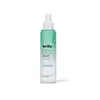What's inside
What's inside
 Key Ingredients
Key Ingredients

 Benefits
Benefits

 Concerns
Concerns

 Ingredients Side-by-side
Ingredients Side-by-side

Water
Skin ConditioningGlycerin
HumectantButylene Glycol
HumectantBetaine
HumectantGlycereth-26
HumectantZeolite
AbsorbentAloe Barbadensis Leaf Extract
EmollientSodium Hyaluronate
HumectantMomordica Charantia Fruit Extract
Skin ConditioningLactobacillus Ferment
Skin ConditioningGlycyrrhiza Glabra Root Extract
BleachingPsidium Guajava Leaf Extract
AstringentRosa Hybrid Flower Extract
Skin ConditioningCamellia Sinensis Leaf Extract
AntimicrobialCentella Asiatica Extract
CleansingHouttuynia Cordata Extract
Skin ConditioningXylitol
HumectantPEG-60 Hydrogenated Castor Oil
EmulsifyingCitric Acid
BufferingSodium Citrate
BufferingEthylhexylglycerin
Skin ConditioningCaprylyl Glycol
EmollientHydroxyacetophenone
AntioxidantLavandula Angustifolia Oil
MaskingCitrus Grandis Peel Oil
MaskingCitrus Aurantifolia Oil
CleansingCitrus Aurantium Dulcis Peel Oil
MaskingMelaleuca Alternifolia Leaf Oil
AntioxidantLimonene
PerfumingWater, Glycerin, Butylene Glycol, Betaine, Glycereth-26, Zeolite, Aloe Barbadensis Leaf Extract, Sodium Hyaluronate, Momordica Charantia Fruit Extract, Lactobacillus Ferment, Glycyrrhiza Glabra Root Extract, Psidium Guajava Leaf Extract, Rosa Hybrid Flower Extract, Camellia Sinensis Leaf Extract, Centella Asiatica Extract, Houttuynia Cordata Extract, Xylitol, PEG-60 Hydrogenated Castor Oil, Citric Acid, Sodium Citrate, Ethylhexylglycerin, Caprylyl Glycol, Hydroxyacetophenone, Lavandula Angustifolia Oil, Citrus Grandis Peel Oil, Citrus Aurantifolia Oil, Citrus Aurantium Dulcis Peel Oil, Melaleuca Alternifolia Leaf Oil, Limonene
Saccharomyces/Xylinum/Black Tea Ferment
Skin ConditioningButylene Glycol
Humectant1,2-Hexanediol
Skin ConditioningNiacinamide
SmoothingGlycerin
HumectantPropanediol
SolventGlycereth-25 PCA Isostearate
EmulsifyingEthylhexylglycerin
Skin ConditioningAdenosine
Skin ConditioningDisodium EDTA
Parfum
MaskingWater
Skin ConditioningTheobroma Cacao Seed Extract
AntioxidantDextrin
AbsorbentHyaluronic Acid
HumectantHydrolyzed Hyaluronic Acid
HumectantSodium Hyaluronate
HumectantCaprylic/Capric Triglyceride
MaskingTocopherol
AntioxidantPhosphatidylcholine
EmulsifyingCeramide NP
Skin ConditioningLeuconostoc/Radish Root Ferment Filtrate
AntimicrobialGlycine
BufferingGlutamic Acid
HumectantSerine
MaskingFructooligosaccharides
HumectantXylose
HumectantAlanine
MaskingLysine
Skin ConditioningArginine
MaskingProline
Skin ConditioningThreonine
Saccharomyces/Xylinum/Black Tea Ferment, Butylene Glycol, 1,2-Hexanediol, Niacinamide, Glycerin, Propanediol, Glycereth-25 PCA Isostearate, Ethylhexylglycerin, Adenosine, Disodium EDTA, Parfum, Water, Theobroma Cacao Seed Extract, Dextrin, Hyaluronic Acid, Hydrolyzed Hyaluronic Acid, Sodium Hyaluronate, Caprylic/Capric Triglyceride, Tocopherol, Phosphatidylcholine, Ceramide NP, Leuconostoc/Radish Root Ferment Filtrate, Glycine, Glutamic Acid, Serine, Fructooligosaccharides, Xylose, Alanine, Lysine, Arginine, Proline, Threonine
 Reviews
Reviews

Ingredients Explained
These ingredients are found in both products.
Ingredients higher up in an ingredient list are typically present in a larger amount.
Butylene Glycol (or BG) is used within cosmetic products for a few different reasons:
Overall, Butylene Glycol is a safe and well-rounded ingredient that works well with other ingredients.
Though this ingredient works well with most skin types, some people with sensitive skin may experience a reaction such as allergic rashes, closed comedones, or itchiness.
Learn more about Butylene GlycolEthylhexylglycerin (we can't pronounce this either) is commonly used as a preservative and skin softener. It is derived from glyceryl.
You might see Ethylhexylglycerin often paired with other preservatives such as phenoxyethanol. Ethylhexylglycerin has been found to increase the effectiveness of these other preservatives.
Glycerin is already naturally found in your skin. It helps moisturize and protect your skin.
A study from 2016 found glycerin to be more effective as a humectant than AHAs and hyaluronic acid.
As a humectant, it helps the skin stay hydrated by pulling moisture to your skin. The low molecular weight of glycerin allows it to pull moisture into the deeper layers of your skin.
Hydrated skin improves your skin barrier; Your skin barrier helps protect against irritants and bacteria.
Glycerin has also been found to have antimicrobial and antiviral properties. Due to these properties, glycerin is often used in wound and burn treatments.
In cosmetics, glycerin is usually derived from plants such as soybean or palm. However, it can also be sourced from animals, such as tallow or animal fat.
This ingredient is organic, colorless, odorless, and non-toxic.
Glycerin is the name for this ingredient in American English. British English uses Glycerol/Glycerine.
Learn more about GlycerinSodium Hyaluronate is hyaluronic acid's salt form. It is commonly derived from the sodium salt of hyaluronic acid.
Like hyaluronic acid, it is great at holding water and acts as a humectant. This makes it a great skin hydrating ingredient.
Sodium Hyaluronate is naturally occurring in our bodies and is mostly found in eye fluid and joints.
These are some other common types of Hyaluronic Acid:
Learn more about Sodium HyaluronateWater. It's the most common cosmetic ingredient of all. You'll usually see it at the top of ingredient lists, meaning that it makes up the largest part of the product.
So why is it so popular? Water most often acts as a solvent - this means that it helps dissolve other ingredients into the formulation.
You'll also recognize water as that liquid we all need to stay alive. If you see this, drink a glass of water. Stay hydrated!
Learn more about Water